A new tutorial video on how you can easily draw curved lines and arrows on Kerika’s canvases and Whiteboards:
Tag Archives: Scrum
Adding a Google Map to your Kerika canvas
Did you know that you can embed a Google Map in your Kerika Whiteboards? It’s easy: just copy the Google Map’s URL:
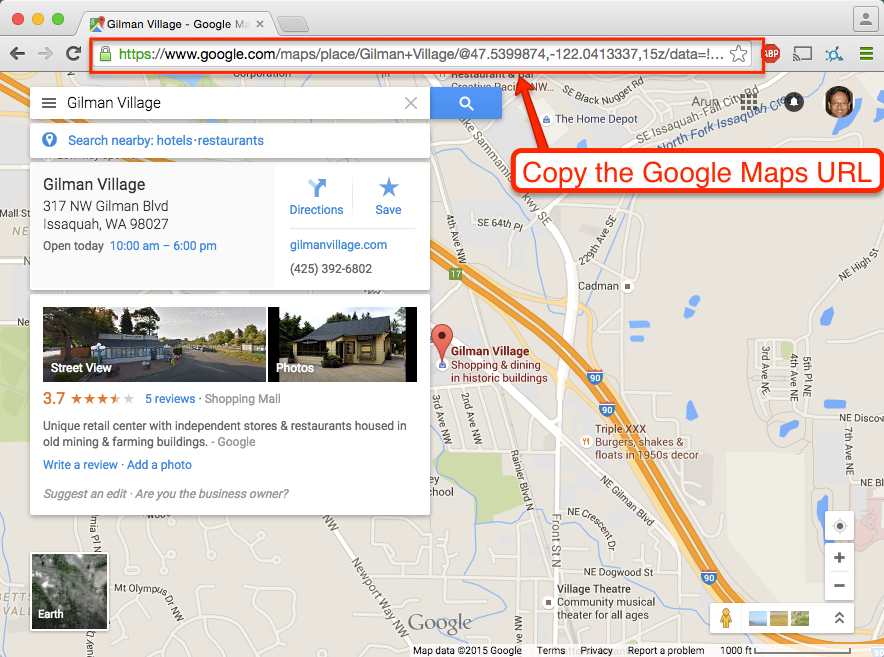
And paste it into the dialog box that appears when you click on the “Add Web Content” button on your canvas toolbar:
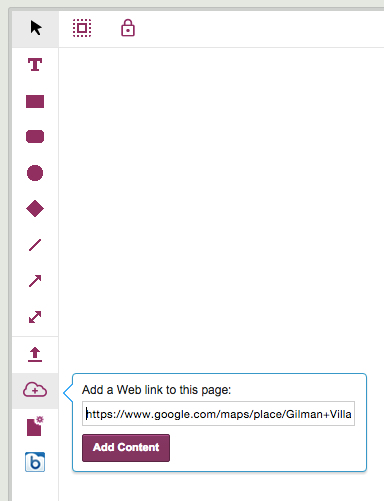
Kerika automatically figures out the URL refers to a Google Map, and shows you an embedded map on your canvas:

You can do the same thing with card attachments, for your Task Boards and Scrum Boards: Kerika shows a small thumbnail of the map in the list of attachments on your card:

UI tweak: removing the “Add member” button from card details
As part of our work on combining tags and colors, we have been cleaning up parts of the Kerika user interface that had minor inconsistencies.
One such inconsistency — in our view — was that you were able to add people to a project team from within the card details dialog itself:
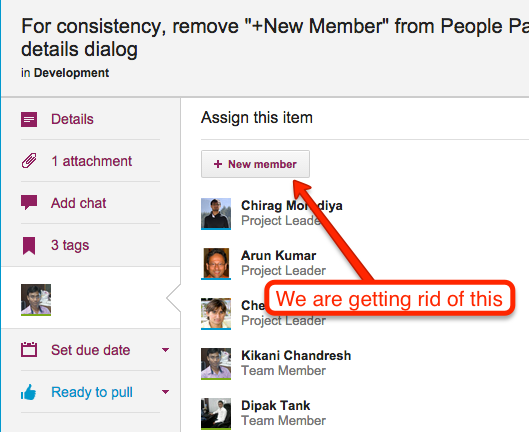
This button has been there in Kerika for a very long time, but it doesn’t really make sense to have this capability within the card details dialog: it just isn’t the best place to decide to add someone to a project team.
Instead, in our new layout the Project Settings dialog consolidates all the board management in one place, including adding people to a team, changing someone’s role within a team, and removing someone from a team:
UI tweak: showing attachments in chronological order
It used to be that when you added content to a card — files from your laptop or Web content from your Intranet or the Internet, or a canvas — the newest content was added at the top of the list.
Of course, you could always rearrange them, by grabbing and dragging them up or down the list, but this it not a feature that many users discovered on their own :-(

Well, for greater consistency with how the chat and history are shown within a card’s details, we are now going to show attachments in chronological order as well — the latest files and URLs that you added to a card will appear at the bottom of the list, and the view of these will be automatically scrolled to show the latest items:
An easy way of keeping track of sub-tasks
With our latest update, it’s become easy to keep track of sub-tasks for cards on a Task Board or Scrum Board; here’s an example:

In the example shown above, the second item in the numbered list has been been taken care of, and so it has been struck-through, making it clear to the rest of the team that it isn’t an issue any more.
We have added the capability of marking text within card details with a strike-through, and this, combined with the easy way in which you can create numbered lists, makes it easy to track sub-tasks!
UI tweaks: new icons to allow for a future feature
At the time we added “In Progress” as a new status value, we also removed the “Done” status, mostly because the drop-down list of status choices was becoming rather long — and “Done” was not quite like all the other choices that we were presenting for marking a card’s status.
This is what the old choices looked like:
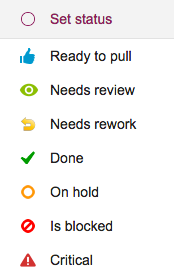
And this is what the new status choices look like:
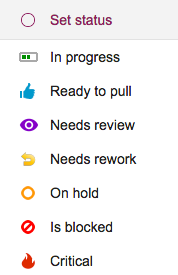
There are two small UI tweaks here that we made:
- A purple color is now used for “Needs review” — this previously was green, but green was really the best choice for “In Progress”, and we didn’t want to use the same color for two different states.
- The icon for “Critical” has been changed to look like a fire: that’s because we want to reuse the old triangle icon in the future for a great new feature that we are still brainstorming — a way to mark certain cards as “troubled”.
UI tweaks: avoiding errors in the right-click menu
Building a great user experience is rarely the result of big, bold actions: more often it is the cumulative gain of a large number of very small tweaks we make to our user interface design.
Here’s an example: the right-click menu, when you click on a card on a Task Board or Scrum Board, used to look like this…
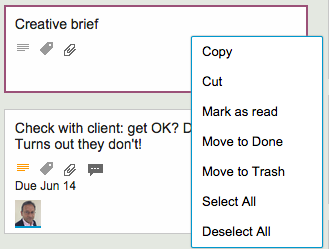
This menu is a little crowded, and one irritating source of errors was that people would sometimes click on one of the Move choices (Move to Done, Move to Trash or Move to Backlog) when they intended to do click on one of the others choices instead.
The irritation came from the fact that these Move operations had a much bigger impact than the others: for example, if you accidentally cut a card, you can reverse that operation by selecting the cut cards once more, which would effectively “undo” the cut.
But, if you move a card to Trash or Backlog, it was a lot more hassle to get it back: you had to make sure the Trash or Backlog was currently being displayed — and in many large boards these columns are routinely hidden from view by the user — and then find and drag that card back to where it was.
So, here’s our small UI tweak to reduce the chances of this error:
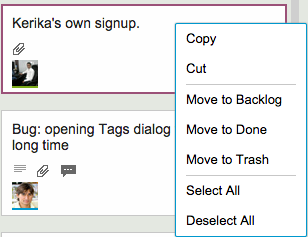
A simple visual cue, in the form of grey horizontal separator lines, helps remind the user that some of these right-click mouse operations are “more significant” than others, by creating a visual segregation of these options from others.
A simple UI tweak that helps reduce errors by our users, and one that adds up to a great user experience!
UI tweaks: Making it easier to restore Archived Projects
In a long, endless series of UI tweaks that are each small in themselves, but which we hope will collectively add up to a great user experience…
We made it easier for Account Owners to restore archived projects and templates:
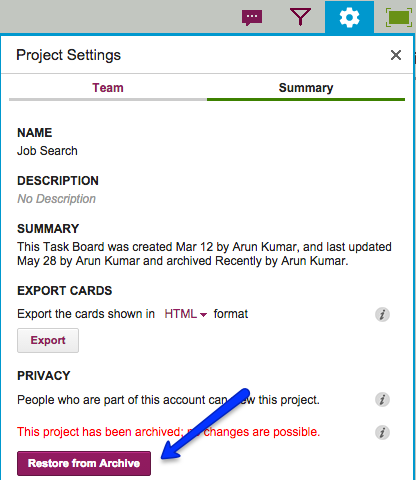
This button is shown only to Account Owners, since the power to archive a project or template, or to restore an archived item, is restricted to the Account Owner.
An improvement to Card History
Every card, on every Kerika Task Board or Scrum Board, contains within it a full history: a log of all the changes that have been made to it.
(A few actions are ignored because they can occur so often, and are often inconsequential, e.g. moving a card up/down within the same column. In contrast, moving a card across columns is considered consequential, and is therefore logged in the card history.)
We recently made a usability improvement in the way the Card History appears: the log of changes is now shown in chronological order, rather than reverse chronological as was the case before.
This makes history look more like chat, and should make it more usable!
Easier to tell who moved a card to your board’s Trash
When a Team Member deletes a card, it just gets moved to the board’s Trash; it doesn’t get immediately deleted from Kerika’s database even though it disappears from your view right away.
That’s because the “delete” action in Kerika is really a “move to Trash” action: you are removing something from view, but not necessarily getting rid of it for good.
Any Team Member can delete a card, but only a Project Leader can completely and permanently get rid of it — in other words, “taking out the trash” is one of the privileges reserved for Project Leaders (and Account Owners).
The Trash column is normally not shown on your Task Board or Scrum Board, but you can bring it view easily by clicking on the Filter button:
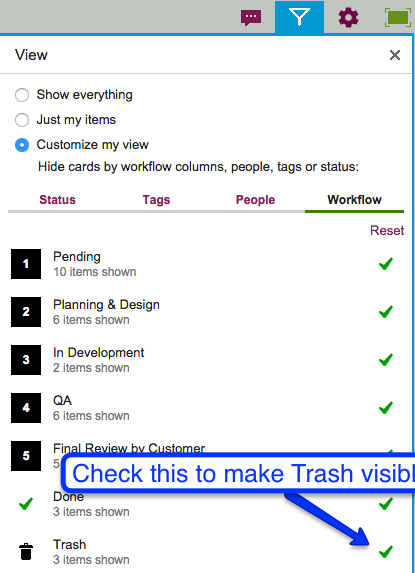
With our latest version, it’s easy to see who moved the card to the Trash: we show this right on the card itself.
